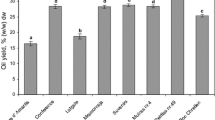Abstract
The fatty acid composition of seeds from seven species of the genusPinus (P. pinaster, P. griffithii, P. pinea, P. koraiensis, P. sylvestris, P. mughus, andP. nigra) was established. Pine seeds are rich in oil (31–68% by weight) and contain several unusual polymethylene-interrupted unsaturated fatty acids with acis-5 ethylenic bond. These are thecis-5,cis-9 18:2,cis-5,cis-9,cis-12 18:3,cis-5,cis-11 20:2, andcis-5,cis-11,cis-14 20:3 acids, with a trace ofcis-5,cis-9,cis-12,cis-15 18:4 acid. Their percentage relative to total fatty acids varies from a low of 3.1% (P. pinea) to a high of 30.3% (P. sylvestris), depending on the species. The majorcis-5 double bond-containing acid is generally thecis-5,cis-9,cis-12 18:3 acid (pinolenic acid). In all species, linoleic acid represents approximately one-half the total fatty acids, whereas the content of oleic acid varies in the range 14–36% inversely to the sum of fatty acids containing acis-5 ethylenic bond. The easily available seeds fromP. koraiensis appear to be a good source of pinolenic acid: their oil content isca. 65%, and pinolenic represents about 15% of total fatty acids. These values appear to be rather constant.Pinus pinaster, which is grown on several thousand acres in the southwest of France, is an interesting source ofcis-5,cis-11,cis-14 20:3 acid (7% in the oil, which isca. 35% of the dehulled seed weight), an acid sharing in common three double bonds with arachidonic acid. Apparently,P. sylvestris seed oil contains the highest level ofcis-5 double bond-containing acids among pine seed oils that have ever been analyzed.
Similar content being viewed by others
References
Takagi, T., and Y. Itabashi,Lipids 17:716 (1982).
Jamieson, G.R., and E.H. Reid,Phytochem. 11:269 (1972).
Berger, A., and J.B. German,Biochim. Biophys. Acta 1085:371 (1991).
Madngal, R.V., and C.R. Smith Jr.,Lipids 10:502 (1975).
Wolff, R.L.,J. Am. Oil Chem. Soc. 71:1129 (1994).
Folch, J., M. Lees and G.M. Sloane-Stanley,J. Biol. Chem. 226:497 (1957).
Morrison, W.R., and L.M. Smith,J. Lipid Res. 5:600 (1964).
Ackman, R.G.,Prog. Chem. Fats other Lipids 12:167 (1972).
Sebedio, J.-L., and R.G. Ackman,J. Chromatogr. Sci. 20:231 (1982).
Author information
Authors and Affiliations
About this article
Cite this article
Wolff, R.L., Bayard, C.C. Fatty acid composition of some pine seed oils. J Am Oil Chem Soc 72, 1043–1046 (1995). https://doi.org/10.1007/BF02660719
Received:
Accepted:
Issue Date:
DOI: https://doi.org/10.1007/BF02660719



